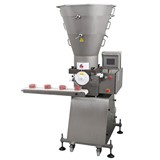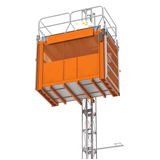Compare telehandler prices in Australia. Get expert tips on costs, specs, financing, and models for construction, farming and industrial use.
Key takeaways
- Telehandler prices range from $80,000 to $180,000+ depending on brand, size, reach, and capacity.
- Compact telehandlers start at $80,000, ideal for tight-access sites.
- Mid-range telehandlers cost $110,000–$140,000, suitable for general use.
- Heavy-duty telehandlers exceed $180,000, built for demanding tasks.
- Telehandler rentals range from $200–$500/day or $1,000–$2,000/week.
- Most common models feature 6–9m lift height and 2.5–3.5t capacity.
- Maintenance costs average $2,000–$5,000 annually, based on usage.
- Telehandler compliance requires AS 2550.19, AS 1418.19, and an LF or CN licence for operators.
Introduction
Telehandlers—also known as telescopic handlers or boom lifts—are versatile lifting machines widely used across construction, agriculture, logistics and mining. Whether you need to lift palletised materials, handle hay bales, or perform elevated maintenance tasks, a telehandler offers height, reach, and manoeuvrability in one machine.
In this guide, we break down everything you need to know to buy the right telehandler in Australia: current prices, machine types, key specs, maintenance needs, compliance requirements, financing options, and answers to common questions.
Types of telehandlers in Australia
1. Compact telehandlers
- Ideal for small sites or indoor use
- Lifting capacity: 1.5–2.5 tonnes
- Lift height: 4–7 metres
2. Standard mid-range telehandlers
- Common in construction and agriculture
- Lifting capacity: 2.5–4 tonnes
- Lift height: 7–12 metres
3. Heavy-duty telehandlers
- Used in mining and heavy construction
- Lifting capacity: 4–6 tonnes or more
- Lift height: 12–20+ metres
4. Rotating telehandlers (Roto)
- 360-degree turret rotation
- Ideal for tight or complex job sites
- Often used with work platforms, jibs, winches
Telehandler prices in Australia
Telehandler prices in Australia can vary widely depending on brand, lift capacity, reach, attachments, and whether the unit is new or used. As of 2025, here's what you can expect to pay:
- Entry-level models (2.5–3.5 tonne, 6–9 metre reach):
For basic tasks on construction or agricultural sites, smaller telehandlers are ideal. New models typically start from $90,000 to $130,000 + GST, depending on brand and included attachments. - Mid-range models (3.5–5 tonne, 9–13 metre reach):
These are the most commonly purchased units across construction and materials handling sectors. Expect prices in the range of $130,000 to $180,000 + GST. These models offer versatility with improved lift height, stability and cab features. - High-capacity models (6–12 tonne, 13+ metre reach):
Designed for heavy-duty applications like mining, ports, and large-scale construction projects. Prices typically start at $190,000 and can exceed $300,000 + GST, especially with added safety features, 4WD, or specialised attachments such as work platforms or pipe handlers. - Used telehandlers:
Buyers can often find good value in the second-hand market. - 5–8-year-old models in working condition usually sell for $45,000 to $90,000 + GST.
- Low-hour or refurbished units may reach $100,000 to $120,000 + GST, depending on brand and service history.
- Attachments and extras:
Accessories like buckets, jibs, fork extensions, and lifting hooks can add between $3,000 and $15,000 depending on type and quality. - Hire-to-buy and rental rates:
Short-term hire costs range from $400 to $1,000/day, or $2,000 to $4,000/week, depending on size and specs. Many suppliers offer rent-to-own agreements with flexible terms for seasonal use or cash flow control.
Operation and usage
- Most telehandlers are 4WD and designed for off-road use.
- Hydraulic attachments (forks, buckets, winches) expand functionality.
- Models with load management systems ensure safety when lifting at height.
- Ensure the unit matches your job site needs for lift height, load weight, and space constraints.
Choosing the right telehandler for your industry
Telehandlers are incredibly versatile, but not all models suit every environment. Selecting the right telehandler depends on your industry's typical loads, terrain, reach requirements, and usage frequency. Here’s what to consider based on your sector:
Construction
Construction sites demand rugged, mid to heavy-duty telehandlers with strong lifting capacity and reliable reach:
- Common features: 6–17m lift height, 2.5–4.5t capacity, 4WD for rough terrain.
- Attachments: Fork tynes, buckets, crane jibs for multi-use on tight sites.
- Why it matters: You need a stable, high-reach machine that can handle uneven ground and tight schedules.
Agriculture
Farmers benefit from compact, manoeuvrable telehandlers that offer multi-tasking flexibility:
- Common features: 6–10m lift, 2.5–3.5t capacity, narrow frames for tight barns or sheds.
- Attachments: Bale grabs, buckets, augers, and forks for feed, hay, and fertiliser handling.
- Why it matters: A smaller footprint and fast cycle times help improve efficiency during peak seasons.
Mining and heavy industry
Harsh environments and high-capacity tasks require the toughest machines:
- Common features: 10–20m lift, 4–6t capacity, reinforced structures, enclosed cabs.
- Attachments: Man baskets, winches, tyre handlers, and dust-proof enclosures.
- Why it matters: Durability, safety features, and operator comfort are critical when machines run long shifts in extreme conditions.
Maintenance and servicing
Regular maintenance ensures safe and efficient performance:
- Daily checks: tyres, forks, fluid levels, safety systems
- Scheduled servicing: every 250–500 hours
- Common parts needing replacement:
- Hydraulic seals
- Tyres
- Filters and fluids
- Lights and wiring
Annual servicing cost typically ranges between $2,000–$5,000.
Telehandler parts and attachments
Essential and optional attachments include:
- Pallet forks
- General purpose buckets
- Crane jibs
- Work platforms (man baskets)
- Bale grabs (agriculture)
- Sweepers
Parts availability is generally good for major brands in Australia. Look for suppliers offering same-day or next-day delivery for fast downtime recovery.
Financing options in Australia
If you’re not buying outright, consider:
- Chattel mortgage – Full ownership with GST claimed upfront
- Finance lease – Rental-style structure, optional balloon payment
- Hire purchase – Ownership at end of term
- Rental/hire – Short-term flexibility, no asset ownership
Most lenders will expect:
- ABN registered business
- Trading history of 12+ months
- Equipment quotes from an authorised dealer
Warranties and support
Most new telehandlers come with:
- Standard 12–24 month warranty
- Optional extended coverage up to 5 years
- Used models may offer 3–6 month dealer warranties
Check what’s covered: engine, hydraulics, electricals, labour, and travel time.
Compliance and certification in Australia
Telehandler use is regulated under:
- AS 2550.19: Cranes, hoists and winches – Telescopic handlers
- AS 1418.19: Design and operational standards
Also note:
- Operators require either CN class licence (non-slewing mobile crane) or LF licence (forklift), depending on use and attachments.
- Machines must be inspected and logged regularly under workplace safety requirements (WHS/OHS).
Common questions from telehandler buyers
- Do I need a special licence to operate a telehandler?
Yes. In Australia, telehandlers with a boom over 3 metres used with a work platform or jib require a CN licence. Standard forklift use requires an LF licence. - What’s the difference between a telehandler and a forklift?
Telehandlers offer better reach (vertical and forward) and are better suited to rough terrain. Forklifts are more compact and ideal for flat indoor surfaces. - Are rotating telehandlers worth the extra cost?
Yes—if your worksite demands high versatility or limited space. Their 360° rotation reduces repositioning and increases efficiency in tight areas. - How long do telehandlers last?
With regular maintenance, telehandlers can last 10,000+ hours, or 10–15 years in moderate use. - Should I buy new or used?
Buy new if uptime and warranty coverage are essential. Used units offer savings but should be inspected by a qualified technician for wear.
Final thoughts
A telehandler is a valuable investment for many industries—from construction to farming. By understanding the types, prices, key specs, and legal responsibilities, you’ll make a more confident and cost-effective decision.
Make sure to compare models, check compliance needs, and factor in maintenance, finance, and warranty options before committing to a purchase.


-160x160-state_article-rel-cat.png)




-160x160-state_article-rel-cat.png)





